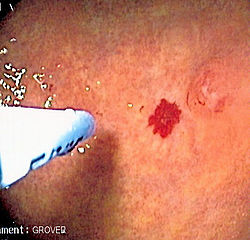| Argon plasma coagulation | |
|---|---|
 Argon plasma coagulation administered via probe through the colonoscope at an angiodysplasia in the colon. The patient had multiple colonic angiodysplasiae in the setting of aortic stenosis. | |
| Other names | APC |
| Specialty | Gastroenterology |
Argon plasma coagulation (APC) is a medical endoscopic procedure used to control bleeding from certain lesions in the gastrointestinal tract. It is administered during gastrointestinal endoscopy such as esophagogastroduodenoscopy or colonoscopy.